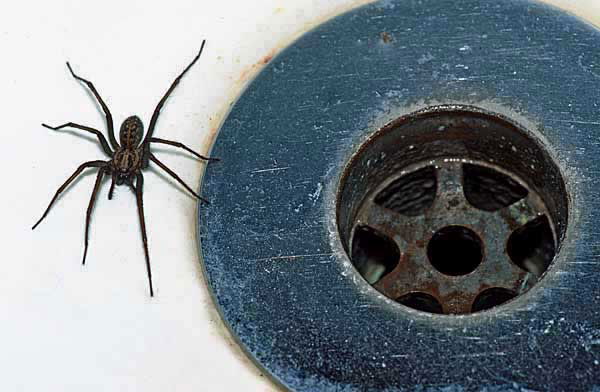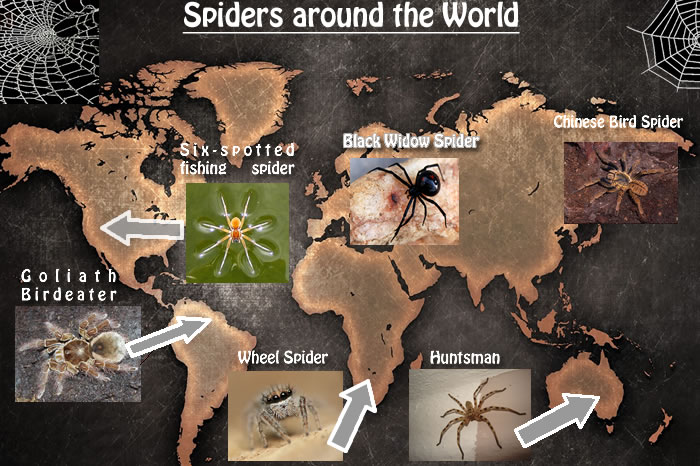News
Top Tips to stop the Autumnal Spider Invasion!
10 October 2014
As a self-confessed arachnophobe, the recent news that UK households were to brace themselves for an invasion of the eight-legged beasties filled me with a very real terror. There has undoubtedly been some unashamed scare mongering, with lurid headlines such as “Fanged cannibal spiders with a ‘bee sting’ bite invade British street” cropping up in the tabloid press. However, it is undeniable that the long, mild Summer has provided the spider population with lots of insects to feed on, and as temperatures drop, they are seeking sanctuary in our cosy centrally heated homes.

The prevalent fear and revulsion associated with spiders has been exploited to terrifying effect in films such as the legendary Arachnophobia – a whole film devoted to a pitched battle with a spider army, in Harry Potter there is the human-devouring spider-giant Aragog, and Shelob of Lord of the Rings fame is a spider “who drinks the blood of elves and men” with equal enthusiasm and is another fearful filmic arachnid villain. Sure, the eight legs can be a bit of a worry when they’re scuttling purposefully towards you (spiders jumping towards me is another dislike), a cobweb in the face is never nice, and the bulbous and numerous eyes are a tad disconcerting, but at the end of the day, they are smaller, and usually less dangerous to us than we are to them.
Apparently, there are evolutionary reasons why females (and even young female infants) are more scared generally of spiders than men – and this is certainly borne out in my own family circle. A study into the subject found that 4 times as many women were likely to be scared of spiders than men were. Researchers have even found that 11-month old girls quickly learned to associate images of spiders and snakes with a fearful facial expression, while baby boys did not.
This is attributed to the fact that men as the “hunter-gatherers” had to be more fearless and risk taking, whilst women were usually the ones who would gather the crops, and come into more frequent contact with spiders and other creepy crawlies.
My personal way of coping with the sight of a huge hairy monster scuttling towards me is to cover it with a cup or other means of restraint, for my hunter-gatherer other- half to deal with, via the piece-of-paper-slid-underneath-method! This strategy works for me…thankfully I have yet to find one who can push the cup off..pheeew!
Homewares company Lakeland offer an intriguing-looking device called the Spider Catcher, which seems to be leading the market in arachnid-removal devices, as they have reported a sales increase of 140% in just one week at the end of September. It allows the user to suck up the offending intruder from a safe-distance (with an extension available for the extra-cautious) and is also good news for the spider, as you can then deposit it outside.
I wondered if there were any other steps that I could take to deter the eight-legged creatures from even considering darkening my door, and have come up with a few suggestions that are certainly worth a try. None of these ideas involve killing spiders. Even as an arachnophobe, I feel great guilt if a spider is killed on my behalf, and they are very useful fly-ensnarers, so I would rather live by the old adage
“If you wish to live and thrive, Let a spider run alive“ – but not near me!!
- Conkers – It’s helpful that the seeds of the horse chestnut tree are to be found in abundance in Autumn to coincide with spider-invasion season. There is no scientific proof about why these would deter potential eight-legged squatters, but many swear by placing them in corners or outside doorways. There is a theory that this supposed aversion is down to the fact that the horse chestnut is not a species native to Britain.
- Lemons, tobacco and peppermint oil – spiders are reportedly less than keen on the pungent scents of all of these substances. You could try putting some tobacco or cut lemons in corners where spiders may lurk, or spraying peppermint, tea-tree or eucalyptus oil around doorways and window-frames.
- Invest in a plug-in. You can buy a plug-in spider deterrent that emits high-pitched sounds that humans can’t hear, but spiders really aren’t keen on. Hopefully, this discomfort will encourage any resident spiders to head for some peace and quiet elsewhere!
- Turn out the lights. Whilst spiders aren’t attracted to light, many of their prey are. Turn off outside lights and block doors/windows where the light might be filtering out. This will reduce the attraction to flying insects, and also the spiders who are lying in wait in their web to ensnare the hapless insects.
- Keep it clean. Again, if you reduce the spider’s food source, you reduce the benefits of sharing your home with you. Clean up crumbs and other food waste that pests are attracted to, plus hoover regularly, and spiders will look for house-room elsewhere. Likewise, keep clutter to a minimum to reduce cosy spider-places to hide. Must be where I’m going wrong!
I hope that these simple and inexpensive measures will help to reduce the number of spiders in your home, and even if they don’t, perhaps the measures above, will at least give you some peace of mind that you are being pro-active in the fight against the invading spider army!
To see a more extensive article on the topic, take a look at ’14 Great Ways to Keep Spiders Out of Your Home Naturally‘ from Tips Bulletin, which has lots of great ideas to try.
The spiders in Britain are fairly tame in comparison to some of the larger, more aggressive and sometimes venomous spiders around the world. Some countries (I’m thinking of Australia, I must confess!) are notorious for their rather alarming spider population. We’ve rounded up a small selection of spiders from different parts of the world, and told you a bit more about them. It does pay to do a little research into the kinds of creatures that you may come across whilst on your travels, but not to let any of our eight-legged friends put you off travel – just remember to pack your trusty Lakeland Spider Catcher or invite along a Hunting-Gathering spider-catcher of the human variety!

Contrary to their name, the Goliath Birdeater doesn’t normally eat birds, their usual diet consists of insects. Females sometimes end up eating their mates and even if they don’t, males will die a year after mating. There are some very strong females in the spider world! They are found in rainforest regions of Northern South America.
The Huntsman is widely recognisable for its regular (and usually unwelcome) appearances in ‘I’m a Celebrity’ and can be found in Australia (as well as other parts of the world). This foreboding creature can have a leg-span of up to 15cm, but its venom isn’t considered dangerous to humans.
The Wheel Spider hails from Southern Africa and, as the name suggests, can cartwheel along the Namibian desert where it lives, trying to avoid becoming the prey of the Pompilid wasps – and I can’t say I blame it! The wasp paralyses the spider with its venomous stinger, drags it into a burrow and lays an egg in its abdomen. The spider is then sealed in the burrow, when the egg hatches, the paralysed spider will be eaten alive from the inside out. I almost feel sorry for it!
The Six-Spotted Fishing Spider is one of at least 4000 known spider species in the US and Canada combined. This particular spider is one of the most common aquatic spiders in the region. They are one of the few animals that can ‘walk’ on water, and they can walk, row, glide and dive on or underneath the surface. They eat lots of insects but can also attack larger prey, such as small fish, frogs, tadpoles or newts. Again, it takes a brave male to approach a female to mate – if the female has already mated, she has no qualms about eating him up!
The Black Widow spider is famous for its venomous nature, and the red hour glass markings on its abdomen. Its bite is widely feared, as its venom is reportedly 15 times stronger than a rattlesnakes. Luckily, their bite is not usually fatal to adults, and they are non-aggressive, only biting in self-defence. They get their name from the fact that females sometimes kill and eat their male counterpart – there’s a theme here! It is the most dangerous spider in Spain, and is more common in the more arid parts of Spain.
Related posts
We’re all going on a working holiday!
12 July 2012Read more
Places to Visit | Travel NewsLondon is the most highly-rated city destination
30 July 2012Read more
Misc | Special EventsA Travel Insurance Policy for Father Christmas
3 December 2012Read more
CompetitionsHidden Gems Travel Competition Entries
7 March 2013Read more